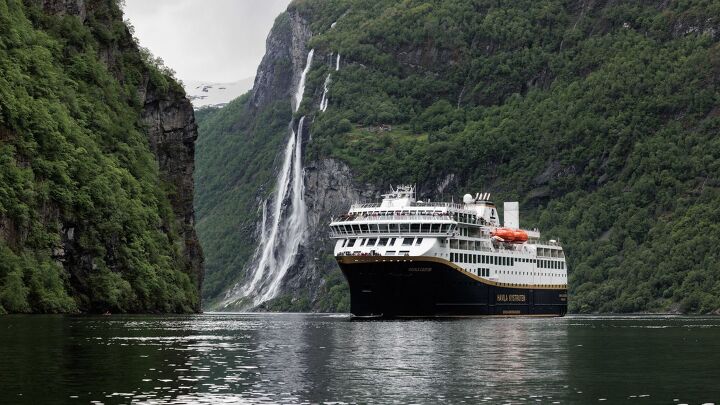Norwegian Cruise Ship Company Says Electricity and Water Don’t Mix

Passengers seeking space for their electric vehicles on vessels operated by Havila Voyages out of Norway are about to find themselves left ashore. The company is taking the advice of a risk analysis firm and refusing to board any electric, hybrid, or hydrogen vehicles on its ships.
To be clear – in spite of what is being suggested by some other outlets – Havila is primarily a cruise ship company, not a huge shipping corporation that floats jumbo vessels like the ill-fated Felicity Ace. There is inherently little space for vehicles, regardless of propulsion method, and they are treated more as cargo than they would be on a traditional roll-on/roll-off ferry. Havila describes these ships as providing ‘coastal voyages’, some of which are up to 12 days in length.
Still, anyone who grew up in a rural seaside town (*raises hand*) knows there is an unwritten expectation that any ship the size of these will reserve at least part of its cargo hold for shipping life’s necessities to far-flung frozen towns – even if official agreements with the Ministry of Transport do not decree this requirement. But many do, being good stewards of the community and all that tripe. Sometimes the cargo includes vehicles, a part of the balance sheet which has apparently frightened the tar out of risk assessment managers and caused the banning of EVs and their ilk for fear of fires that would be difficult to extinguish.
These are valid concerns, to be sure, especially given the suspected reason for the loss of the Felicity Ace mentioned earlier. Even internal combustion cars don’t rank too high on Havila’s top-40 as cargo, with the company reducing to just two the number of ports at which it will offload vehicles, citing tidal considerations and the like.
There is an uncomfortable realization that Havila’s own ships deploy enormous battery packs in their daily plying of the seas, but company spox say those elements of vessel propulsion are safely encased in separate rooms which have special fire suppressors which may not be available elsewhere on the boat.
Remember these facts when, inevitably, your Uncle Walt shares a fake news story on Facebook with a breathless headline shouting ‘SHIPPING COMPANIES WON’T BRING ELECTRIC CARS HERE ANYMORE’ or ‘YOU CAN’T PUT AN EV ON A FERRY NOW’. Speaking quickly to the latter, a German-based company has installed EV chargers on several of its vessels serving a number of routes.
[Images: Havila]
Become a TTAC insider. Get the latest news, features, TTAC takes, and everything else that gets to the truth about cars first by subscribing to our newsletter.

Matthew buys, sells, fixes, & races cars. As a human index of auto & auction knowledge, he is fond of making money and offering loud opinions.
More by Matthew Guy
Latest Car Reviews
Read moreLatest Product Reviews
Read moreRecent Comments
- Theflyersfan I know their quality score hovers in the Tata range, but of all of the Land Rovers out there, this is the one I'd buy in a nanosecond, if I was in the market for an $80,000 SUV. The looks grew on me when I saw them in person, and maybe it's like the Bronco where the image it presents is of the "you're on safari banging around the bush" look. Granted, 99% of these will never go on anything tougher than a gravel parking lot, but if you wanted to beat one up, it'll take it. Until the first warning light.
- Theflyersfan $125,000 for a special M4. Convinced this car exists solely for press fleets. Bound to be one of those cars that gets every YouTube reviewer, remaining car magazine writer, and car site frothing about it for 2-3 weeks, and then it fades into nothingness. But hopefully they make that color widespread, except on the 7-series. The 7-series doesn't deserve nice things until it looks better.
- Master Baiter I thought we wanted high oil prices to reduce consumption, to save the planet from climate change. Make up your minds, Democrats.
- Teddyc73 Oh look dull grey with black wheels. How original.
- Teddyc73 "Matte paint looks good on this car." No it doesn't. It doesn't look good on any car. From the Nissan Versa I rented all the up to this monstrosity. This paint trend needs to die before out roads are awash with grey vehicles with black wheels. Why are people such lemmings lacking in individuality? Come on people, embrace color.


































Comments
Join the conversation
I wonder if readers here know how EVs deal with regulations around battery packs spontaneously catching fire: The pack must contain the fire for 60 seconds; the user is warned to get the H out of the vehicle. After 60 seconds, all bets are off, and the battery is allowed to go full China Syndrome. Don't ask me how this solves anything if the car is parked in your garage, and it's the middle of the night...
And before you tell me ICE cars catch fire too, that typically happens on the open road in old and poorly maintained vehicles. A relatively new ICE car isn't going to cook off while sitting in your garage.
I did some digging. This applies to 2 ships owned by one repeat one cruise line. The ships don't have sufficient fire suppression equipment to handle electrical fires.
Banning all EV's from ferries would be bad business considering the number of EV's in Norway.
This site gets more clicks by flinging red meat on the gas stove than doing actual journalism.